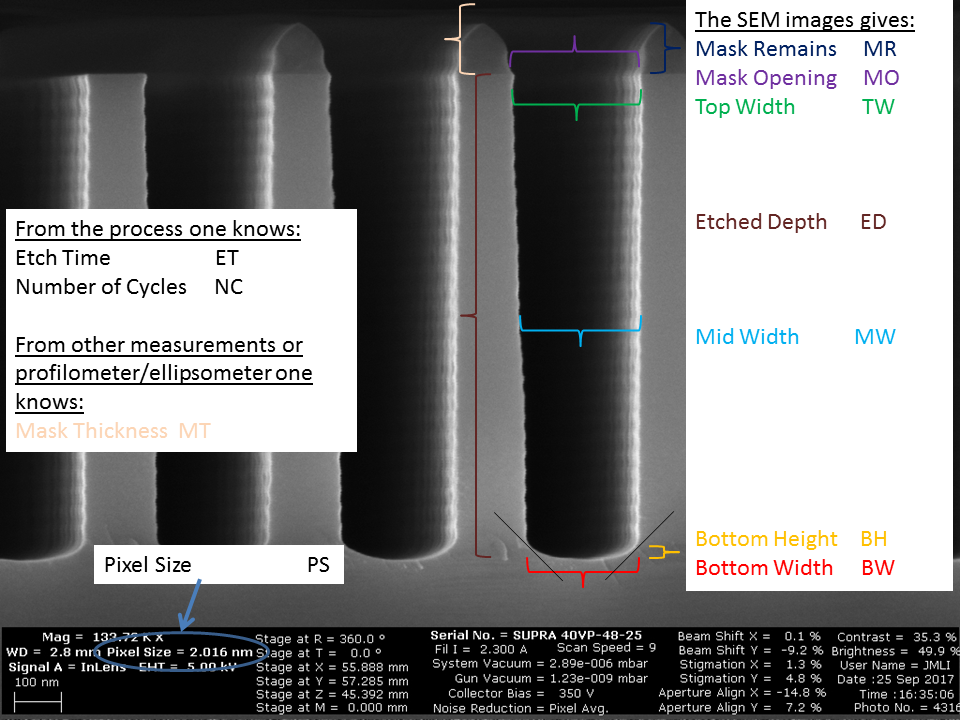Specific Process Knowledge/Etch/DRIE-Pegasus/TrenchCharacterisation: Difference between revisions
| Line 95: | Line 95: | ||
The numbers and measurements above provide a reasonable good basis for comparing DRIE trenches. They do, however, not take the following aspects into account: | The numbers and measurements above provide a reasonable good basis for comparing DRIE trenches. They do, however, not take the following aspects into account: | ||
* | * '''Complex sidewall profiles''': The numbers give most sense if the profiles are almost straight. The more they deviate, the more nonsense... | ||
** Excessive bowing | |||
** Undercut features | |||
* '''Aspect ratio dependent etching''': Trenches with high aspect ratios typically etch faster in the beginning of the etch process compared to the end because of aspect ratio dependent etching | |||
Revision as of 10:26, 29 June 2018
Characterization of DRIE silicon trenches
Deep silicon trenches come in many sizes and shapes. The best way of characterizing them is to cleave the wafer perpendicular to the trench and inspect the profile in an SEM or optical microscope. In the SEM the challenge is to get the best information possible about the profile with as little effort as possible. The information acquired must be simple and useful. Below is an example.
Input parameters
At the SEM
Many users make measurements using the annotations in the SEM. However, instead of adding a ton of measurements to each SEM image while at the SEM and hence spend an unreasonable amount of time there, one can postpone making the measurements till afterwards. The only requirement is that the pixel size of every SEM image is known - one can add it to the datazone: See any SEM manual for instructions - for instance HERE
Making measurements
Opening the SEM images with Irfanview (or any other image viewer with the same possibilities) and drawing squares (the pixel dimensions are shown in the top) as measurements. These squares are one pixel wide compared to the 2 (or even 3) which are default for the annotations in smartSEM.
- Pixel Size (PS)
- Shown in the datazone or read from the tiff header.
- Number of cycles (NC)
- In case of a Bosch process, the number of cycles may be used instead of the process time.
- Etch Time (ET)
- The duration of the etch process expressed as a number (5.5 minutes rather than mm:ss 5:30).
- Mask Thickness (MT)
- The thickness of the mask prior to etching.
- Mask Remains (MR)
- The thickness of the mask after etching.
- Mask Opening (MO)
- The width of the mask opening measured at the mask/substrate interface.
- Top Width (TW)
- The narrowest part of the open feature near the mask/substrate interface.
- Mid Width (MW)
- The width of the trench at half the distance to the bottom of the trench.
- Bottom width (BW)
- The width of the trench at the bottom. As many trenches have more or less rounded corners at the bottom, this point defined to be where the slope passes 45 degrees to the surface as indicated in the SEM image above with black bars.
- Bottom Height (BH)
- The height difference between the 'Bottom width' points and the center of the trench.
- Etched Depth (ED)
- The distance from the top to the bottom of the trench..
Output parameters
Assuming that all measurements in the image are done in pixels (as described above) rather than in microns/nanometers:
- Etched depth (nm or µm)
- The etched depth (ED) is rather self explanatory: ED PS
- Etch rate (expressed either as nm/min or µm/min or as nm/cyc or µm/cyc)
- Divide the etched depth (ED) by the etch time (ET) or the number of Bosch cycles (NC) of the process:
- or
- Sidewall bowing (%)
- The sidewall bowing is a measure of how much the sidewall profile at mid-depth deviates from a straight line drawn between the top width and bottom width points - regardless of what angle it is at:
- or
- with
- Mask etch rate (nm per min.)
- Selectivity
- CD loss (nm per edge)
- Sidewall angle (degrees)
- or
- with
What the numbers fail to represent or ignore
The numbers and measurements above provide a reasonable good basis for comparing DRIE trenches. They do, however, not take the following aspects into account:
- Complex sidewall profiles: The numbers give most sense if the profiles are almost straight. The more they deviate, the more nonsense...
- Excessive bowing
- Undercut features
- Aspect ratio dependent etching: Trenches with high aspect ratios typically etch faster in the beginning of the etch process compared to the end because of aspect ratio dependent etching

